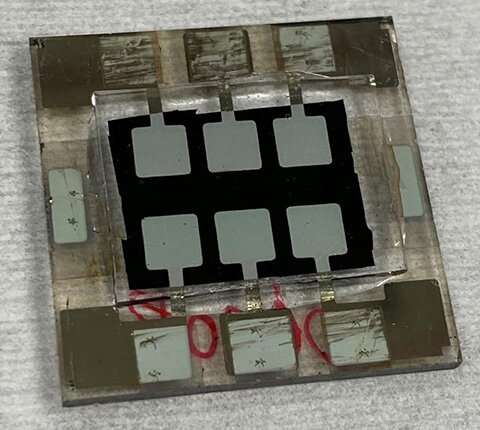
Scientists at the U.S. Department of Energy’s National Renewable Energy Laboratory (NREL) have demonstrated a tin-lead perovskite cell that overcomes problems with stability and improves efficiency. The new cell, a tandem design with two layers of perovskites, measured a 25.5% efficiency.
Perovskites have emerged as a highly efficient material for solar cells, but research continues to make the technology longer lasting.
The new NREL cell retained 80% of its maximum efficiency after 1,500 hours of continuous operation, or more than 62 days.
“This represents an accelerated aging test in the lab,” said Kai Zhu, a senior scientist at NREL and co-author of a new paper detailing the research. “At this tandem efficiency level, the best reported stability in literature is normally several hundred hours.”
Details about the new cell are spelled out in “Carrier control in the Sn-Pb narrow-bandgap perovskites via 2D cation engineering for all-perovskite tandem solar cells with improved efficiency and stability,” which appears in the journal Nature Energy.
Perovskite refers to a crystalline structure rather than to a specific element such as silicon, and the solar cells are made from a chemical solution affixed to a substrate. The two corresponding authors, Kai Zhu and Jinhui Tong, said a tandem perovskite cell, in which two layers are joined to capture slightly different slices of the solar spectrum, can be more than 30% efficient.
The other co-authors from NREL are Qi Jiang (co-first author), Andrew Ferguson, Axel Palmstrom, Ji Hao, Sean Dunfield, Amy Louks, Steven Harvey, Haipeng Lu, Ryan France, Fei Zhang, Mengjin Yang, John Geisz, Matthew Beard, Darius Kuciauskas, and Joseph Berry. Other contributors are from the University of Colorado–Boulder and the University of Toledo.
Many of these researchers demonstrated in a 2019 paper published in the journal Science a tin-lead tandem perovskite cell with an efficiency measured at 23.1%. They compensated for any problems caused by tin by adding the chemical compound guanidinium thiocyanate, which resulted in marked improvements in the structural and optoelectronic properties of the cell. Solar cells create electricity when sunlight triggers the movement of electrons. A longer carrier lifetime associated with the movement improves the efficiency of the cell. The addition of guanidinium thiocyanate bolstered the carrier lifetime from less than 200 nanoseconds (each nanosecond is a billionth of a second) to 1 microsecond (or a millionth of a second).
Improving upon that earlier experiment, the scientists added phenethylammonium iodide along with guanidinium thiocyanate. The improved tin-lead perovskite saw its carrier lifetime increase to about 9 microseconds. The combined additives also reduced the defect density associated with tin oxidation to a level unprecedented for tin-lead perovskites and similar to the values for lead-only perovskites.
The new cell also demonstrated an improvement in the voltage generated, at 2.1142 volts. In comparison, the best certified tandem device registered 2.048 volts.
Adding guanidinium thiocyanate to mixed tin-lead perovskites to improve solar cell efficiency
Jinhui Tong et al, Carrier control in Sn–Pb perovskites via 2D cation engineering for all-perovskite tandem solar cells with improved efficiency and stability, Nature Energy (2022). DOI: 10.1038/s41560-022-01046-1
Citation:
New additives to perovskite tandem solar cells boost efficiency, stability (2022, June 15)
retrieved 15 June 2022
from https://techxplore.com/news/2022-06-additives-perovskite-tandem-solar-cells.html
This document is subject to copyright. Apart from any fair dealing for the purpose of private study or research, no
part may be reproduced without the written permission. The content is provided for information purposes only.
For all the latest Technology News Click Here
For the latest news and updates, follow us on Google News.

